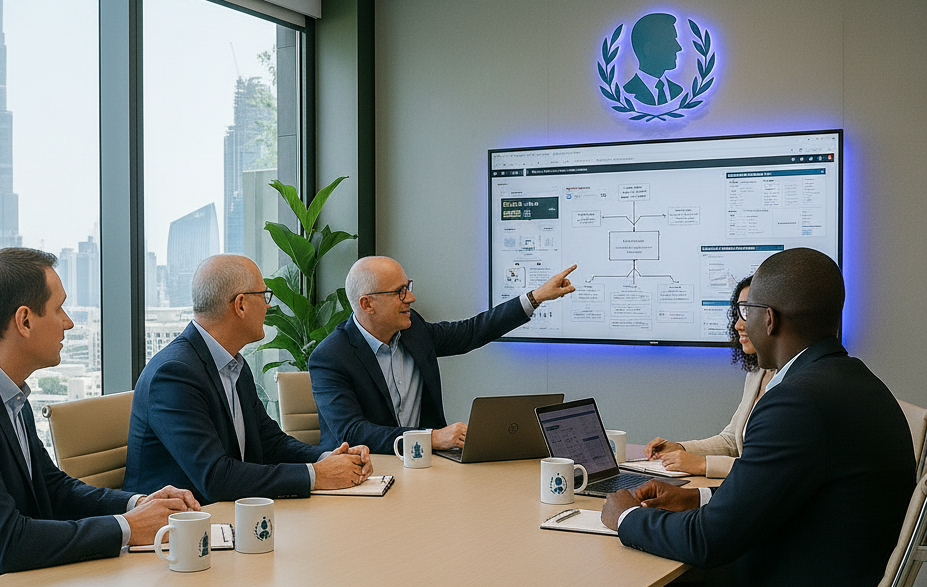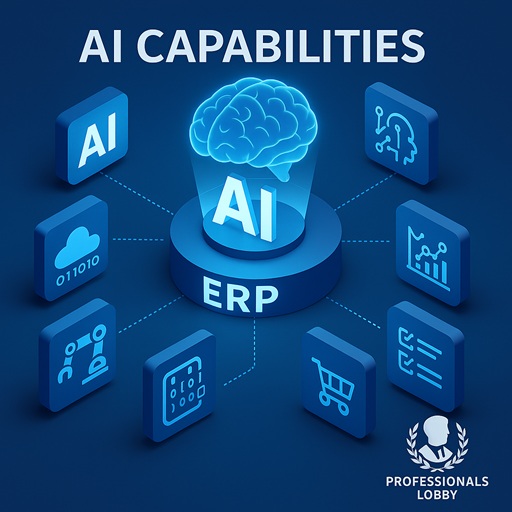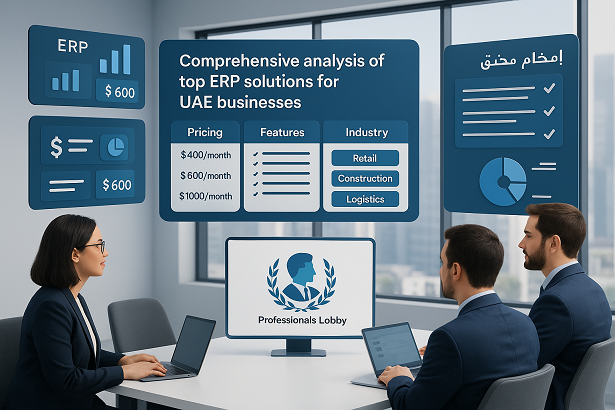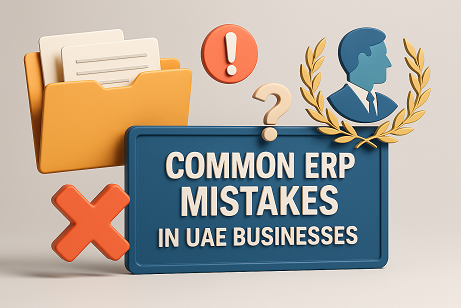Choosing an ERP is one of the highest-impact IT decisions a company makes: it touches finance, procurement, inventory, HR, projects, manufacturing, sales, compliance and reporting. In the UAE — with its mix of free zones, multinational operations, Arabic language needs, VAT and rapid growth — the right ERP brings operational control and future scalability; the wrong choice costs time, money and credibility.
Key Takeaways
- Start with clear business goals and measurable outcomes
- Prioritize UAE-specific requirements like VAT compliance and Arabic support
- Use a weighted scoring matrix for objective vendor evaluation
- Leverage AI to accelerate vendor analysis and selection
- Plan for data migration and change management from day one
Quick Navigation
1. Start with a Clear Business Case and Goals
Before evaluating products, document your specific requirements and objectives. This foundation will guide your entire selection process.
Business Goals (3–5 measurable outcomes)
- Reduce month-end close from 10 to 3 days
- Cut stock carrying costs by 15%
- Unify 6 subsidiaries on one instance
- Support e-commerce integration
- Improve decision-making with real-time analytics
Scope (modules required now vs later)
- Core finance & accounting
- Inventory management
- MRP & production
- POS & retail operations
- Payroll & HR management
- CRM & sales
- Projects & service management
- BI & analytics
Budget (Total Cost of Ownership)
- Software licensing/subscription
- Implementation services
- Customization & integration
- Training & change management
- 3-5 years of support & maintenance
- Hardware/infrastructure costs
Constraints & Considerations
- Legacy systems integration
- Data quality & migration complexity
- Key processes that must remain
- Staff availability for training
- Regulatory compliance requirements
Professionals Lobby Insight:
"Vendors sell solutions; your clear outcomes let you compare proposals objectively. Documenting measurable goals upfront prevents scope creep and ensures the selected ERP delivers tangible business value."
2. UAE-Specific Requirements (Must-Check Items)
When evaluating ERP options for Dubai, Abu Dhabi, and other Emirates, confirm these critical UAE-specific capabilities:
VAT & Taxation
- VAT invoicing with proper tax calculations
- VAT reporting and audit trails compliant with FTA requirements
- Tax group handling for multiple entities
- Reverse charge mechanism support
Arabic Language Support
- Bilingual user interface (Arabic/English)
- RTL (Right-to-Left) support for invoices and reports
- Arabic customer/vendor master data
- Localized date formats (Hijri/Gregorian)
Payroll & Labor Law Compliance
- UAE gratuity calculations
- Labor contract management
- WPS (Wage Protection System) integration
- Multi-country payroll for GCC operations
Multi-Company Operations
- Multi-entity consolidation
- Free zone company support
- Multi-currency handling (AED, USD, others)
- Intercompany transactions
Local Integrations
- UAE banking integration
- Payment gateway connections
- POS hardware compatibility
- Customs/ports systems (for logistics)
Local Support & Implementation
- UAE-based implementation partner
- Local support with Arabic-speaking consultants
- Quick response times for critical issues
- Regular regulatory updates
3. Build Your Short List — Key ERP Categories
ERP vendors fall into distinct categories. Match the category to your business size, complexity, and budget:
Global Tier-1 ERP
Enterprise Grade- Examples: SAP S/4HANA, Oracle Fusion, Microsoft Dynamics 365 Finance
- Best for: Large enterprises, complex multi-legal structures
- Implementation: 6-18 months, high customization
- Cost: High ($500K+ implementation)
Mid-Market Cloud ERP
SME Focused- Examples: NetSuite, Acumatica, Odoo Enterprise, Business Central
- Best for: Multi-entity SMEs, regional groups
- Implementation: 3-9 months, moderate customization
- Cost: Medium ($100K-300K implementation)
Industry-Specialized ERP
Vertical Solutions- Examples: LS Retail, Epicor, Infor industry suites
- Best for: Specific sectors (retail, manufacturing, construction)
- Implementation: 2-6 months, minimal customization
- Cost: Variable ($50K-200K implementation)
Local/Regional Solutions
UAE Focused- Examples: Focus 9, Elite Mindz, Compass ERP
- Best for: UAE SMEs needing rapid localization
- Implementation: 1-4 months, pre-configured
- Cost: Lower ($20K-80K implementation)
4. Evaluation Criteria & Scoring Matrix
Use a weighted scorecard to compare proposals objectively. Here's our recommended weighting system:
| Criterion | Weight | Description | Scoring (0-5) |
|---|---|---|---|
| Functional Fit | 25% | Process coverage and out-of-box functionality | 0=Poor, 5=Excellent match |
| Total Cost of Ownership (5-yr) | 20% | Licensing, implementation, support costs | 0=Very high, 5=Very competitive |
| Implementation Timeframe & Risk | 15% | Project duration and complexity | 0=High risk, 5=Low risk |
| Vendor Stability & Reputation | 10% | Vendor track record and financial health | 0=Unstable, 5=Very stable |
| Local Support & Partner Capability | 10% | UAE presence and expertise | 0=No local support, 5=Excellent support |
| Technology & Integrations | 10% | APIs, cloud readiness, connectivity | 0=Outdated, 5=Modern & flexible |
| Security/Compliance | 5% | Data protection and regulatory compliance | 0=Weak, 5=Strong |
| UX & Training | 5% | User experience and learning curve | 0=Complex, 5=Intuitive |
Interactive Scoring Tool
5. Using AI to Accelerate ERP Selection
Artificial Intelligence can dramatically speed up vendor analysis, RFP processing, and implementation planning.
Vendor Shortlisting
Feed vendor brochures and demo notes to AI to extract capabilities and identify gaps
RFP Analysis
Use AI to score vendor responses against your criteria and detect inconsistencies
Data Migration Planning
AI can propose field mappings from legacy systems to target ERP
Process Optimization
Analyze transaction patterns post-implementation to recommend improvements
Advanced AI Prompt for Vendor Comparison
"You are an ERP procurement analyst specializing in UAE businesses. Here are three vendor proposals. Extract a comparison table with: functional coverage per module (yes/partial/no), estimated 5-year TCO, implementation timeline, local UAE references, customizations required, and a risk score (low/medium/high) with reasoning. Focus particularly on UAE VAT compliance and Arabic language support."
6. Must-Have vs Nice-to-Have Checklist
Prioritize your requirements with this essential checklist for UAE ERP implementations:
Must-Have Requirements
Nice-to-Have Features
7. Typical Vendor Selection Timeline
Here's a realistic timeline for the ERP selection process in the UAE context:
Weeks 0-2: Foundation
Finalize business case, scope, budget constraints, and selection criteria
Weeks 3-6: Vendor Shortlisting
RFP distribution, initial demos, and narrowing to 2-4 qualified vendors
Weeks 7-10: Deep Evaluation
Detailed demos, proof of concept, sandbox testing with your data
Weeks 11-12: Final Selection
Reference checks, TCO finalization, contract negotiation
Weeks 13+: Implementation
Phased deployment (typically 3-18 months depending on complexity)
8. Practical Tips & Red Flags
Success Tips
Easier upgrades and lower long-term costs
Test with your sample data before commitment
Link payments to delivered functionality
Red Flags
Lack of proven UAE implementation experience
Unclear data migration strategy or hidden costs
Heavy customization suggests poor fit
Frequently Asked Questions
Costs vary widely by scope. Small deployments start around $20,000-$50,000, while large multi-entity implementations can exceed $500,000. Always calculate Total Cost of Ownership (TCO) over 5 years including licensing, implementation, customization, and ongoing support.
Cloud ERP accelerates deployment and reduces infrastructure costs. On-premise may be necessary for strict data residency requirements or complex custom integrations. Most UAE businesses now prefer cloud solutions for their scalability and lower upfront investment.
Ask for UAE client references, verify onshore consultant availability, check support SLAs, and confirm experience with your industry. A strong local partner is crucial for VAT compliance updates and timely support.
Most modern ERPs support bilingual output, but verify RTL (Right-to-Left) rendering in invoices, financial reports, and customer portals. Request to see actual samples during demonstrations.
Selection process: 2-3 months. Implementation: 3-18 months depending on complexity. Phased rollouts (pilot → business units → full deployment) help manage risk and ensure user adoption.
Next Steps for Your ERP Selection
ERP selection is both technical and strategic. Your strongest predictor of success is clarity: clearly defined business outcomes, a disciplined selection process, local partner capacity, and investment in change management.
Schedule a Free Consultation
Discuss your specific requirements with our ERP experts.
Book ConsultationFinal Expert Advice
"Use AI to accelerate analysis — but always validate critical financial and compliance claims with human experts and local references. The right ERP partner becomes a strategic asset for your UAE business growth."
— Professionals Lobby ERP Consulting Team



